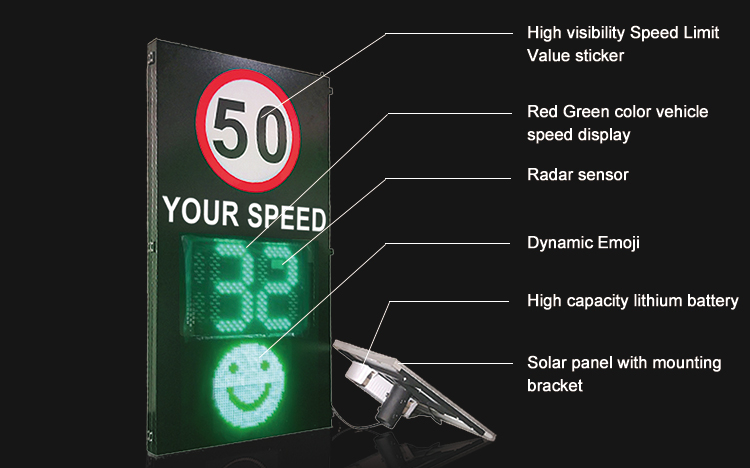The Comprehensive Guide to Radar Speed Signs: Enhancing Road Safety with Smart Technology

Introduction to Radar Speed Signs
Radar speed signs, also known as driver feedback signs or dynamic speed displays, are intelligent traffic devices designed to monitor vehicle speeds and display real-time feedback to drivers. Unlike traditional static speed limit signs, these solar- or electric-powered units actively engage motorists by combining radar technology with bright LED displays. This guide explores how radar speed signs work, their benefits, applications, and how they’re revolutionizing traffic management worldwide.
Chapter 1: How Radar Speed Signs Work
1.1 The Science Behind Radar Technology
Radar speed signs utilize Doppler radar—a system that calculates speed by measuring the frequency shift of radio waves reflected off moving vehicles. When a vehicle approaches the sign, the radar sensor emits a signal and analyzes the returning wave to determine speed. This data is instantly displayed on the sign’s LED screen, often accompanied by a warning like “SLOW DOWN” if the vehicle exceeds the speed limit.
1.2 Key Components of a Radar Speed Sign
- Radar Sensor: Detects vehicle speed with ±1 mph accuracy.
- High-Visibility LED Display: Shows real-time speed in large, bold digits.
- Data Logging Module: Stores speed data for traffic analysis (optional).
- Power Source: Solar panels, batteries, or hardwired electrical connections.
1.3 Customizable Features for Diverse Needs
Modern radar speed signs offer adjustable settings for:
- Speed threshold alerts (e.g., flashing lights at 10% above the limit).
- Multilingual displays or symbols for international use.
- Integration with traffic management systems via Wi-Fi or cellular networks.
Chapter 2: Benefits of Radar Speed Signs
2.1 Proven Reduction in Speeding Violations
Studies by the Federal Highway Administration (FHWA) show radar speed signs reduce average speeds by 5–10 mph in high-risk zones. For example, a 2022 trial in Austin, Texas, saw a 34% drop in speeding incidents after installing radar signs near schools.
2.2 Cost-Effective Traffic Calming
Compared to speed bumps or manned enforcement, radar signs provide 24/7 speed deterrence at a fraction of the cost. Municipalities report ROI within 6–12 months due to fewer accidents and reduced police workload.
2.3 Enhanced Driver Awareness
By delivering instant feedback, these signs encourage self-correction. Drivers often underestimate their speed; visible displays make them conscious of their behavior without punitive measures.
2.4 Data-Driven Decision Making
Advanced models collect anonymized traffic data, helping cities:
- Identify peak speeding hours.
- Evaluate the effectiveness of traffic calming initiatives.
- Justify infrastructure investments with hard metrics.
Chapter 3: Applications of Radar Speed Signs
3.1 School Zones
Radar speed signs with flashing amber lights are mandatory in many U.S. school districts. They’re programmed to activate during pickup/drop-off times, prioritizing child safety.
3.2 Construction Zones
Temporary radar signs protect workers by alerting drivers to reduced speed limits. Solar-powered portable units are ideal for changing job sites.
3.3 Residential Neighborhoods
Homeowner associations use radar signs to combat cut-through traffic. Some communities pair them with “Your Speed” displays to foster accountability.
3.4 Corporate Campuses and Parking Lots
Private entities deploy radar signs to manage internal traffic flow and reduce liability risks.
Chapter 4: Choosing the Right Radar Speed Sign
4.1 Fixed vs. Mobile Units
- Fixed Signs: Permanently installed for long-term enforcement.
- Mobile/Trailer-Mounted Signs: Easily relocated for temporary needs like events or roadwork.
4.2 Key Specifications to Compare
- Detection Range: 300–1,500 feet, depending on model.
- Visibility: Look for 18″–24″ high-contrast LEDs readable in direct sunlight.
- Durability: Aluminum housings with IP67 waterproof ratings for all-weather use.
4.3 Top Brands in 2024
- TrafficLogix: Known for solar-powered SafePace systems.
- Radar Signs LLC: Offers rugged, customizable SpeedAlert models.
- VerMac: Specializes in trailer-mounted solutions for construction zones.
Chapter 5: Installation and Maintenance Best Practices
5.1 Optimal Placement Strategies
- Position signs 100–200 feet before hazard zones (e.g., crosswalks).
- Avoid obstructions like trees or billboards that block visibility.
5.2 Power Options Demystified
- Solar: Low maintenance but requires 4+ hours of daily sunlight.
- Battery: Rechargeable lithium-ion packs last 2+ weeks.
- Hardwired: Ideal for urban areas with reliable grid access.
5.3 Routine Maintenance Checklist
- Clean solar panels monthly to maximize efficiency.
- Update firmware annually for enhanced cybersecurity.
- Calibrate radar sensors every 12–18 months.
Chapter 6: The Future of Radar Speed Signs
6.1 AI Integration for Predictive Analytics
Next-gen signs will use machine learning to predict traffic patterns and adjust messaging dynamically.
6.2 Vehicle-to-Infrastructure (V2I) Communication
Radar signs may soon transmit speed data directly to connected cars, enabling automatic speed adjustments.
6.3 Solar Technology Advancements
Graphene-coated solar panels could double energy efficiency, making off-grid installations viable in cloudy climates.
Conclusion: Why Invest in Radar Speed Signs?
Radar speed signs are no longer optional—they’re a critical tool for modern traffic management. By reducing speeds, saving lives, and providing actionable insights, they deliver unparalleled value to communities and organizations. Whether you’re a city planner, school administrator, or private business owner, implementing radar speed signs is a proactive step toward safer, smarter roads.
References:
- FHWA Study on Speed Display Effectiveness (2021)
- National Highway Traffic Safety Administration (NHTSA) Speed Fatality Data
- Case Study: Austin ISD School Zone Safety Initiative
